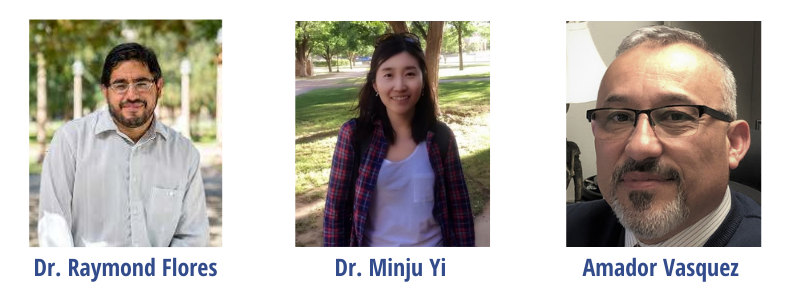Guest blog by Calvin J. Stocker
Thoughtful approaches to partnerships with district partners are core to the most effective teacher preparation programs in the nation. Without district input and collaboration, all of the preparation of a future teacher candidate is for naught. Dr. Raymond Flores, an associate professor of mathematics education in the Department of Teacher Education at Texas Tech University, understands this well. Through all of my experiences with him as a math educator, Dr. Raymond Flores is always the first to ask this: What are the needs of the district and the students it serves?
Raymond exemplifies the characteristics of a faculty leader focused on connecting theory to practice, ensuring that teacher candidates have access and experience to the very best teacher preparation as they work to become effective, life-long educators. This approach to math teacher educator practices and development has launched Texas Tech University and its candidates into the future of effective teaching practices. I recently sat down with Dr. Flores, his colleague Dr. Minju Yi, a Postdoc at Texas Tech, and his district partner Amador Vasquez, the K12 Mathematics Coordinator for Lubbock ISD. Together, they shared their approach to teacher preparation and district partnership.

CALVIN: I’ve heard you speak quite a bit about providing your teacher candidates with practice-based opportunities. Can you tell me what inspired you to integrate practice-based opportunities in the mathematics courses here at Texas Tech and how you then came to partner so closely with the school district?
RAYMOND: When I first came to Texas Tech in the Fall of 2013, Dean Scott Ridley was really invested in reforming the entire teacher education department in our college. The goal was to create a stronger, more cohesive program for teacher candidates by aligning courses and ensuring those courses built on one another. Under the leadership of Dr. Jian Wang, Professor & Helen DeVitt Jones, Chair in Teacher Education at Texas Tech, we started redesigning our mathematics methods courses based on teacher education research, K12 mathematics standards, Texas teacher licensure standards and our district partner’s needs. This work included defining the learning outcomes of these courses, organizing course content and interventions into modules, designing and embedding data collection into courses, implementing course interventions, monitoring and collecting data, analyzing data from courses, and redesigning course assessments and interventions based on results. Additionally, as we began making these shifts, I reached out to Amador Vasquez, K12 Math Coordinator at Lubbock Independent School District. As we were making shifts to our programming, it made sense to connect with our partner district and ensure we were working together to best prepare candidates.
AMADOR: We both shared a vision for teaching mathematics to kids conceptually, so we started to discuss what math teacher candidates really needed to learn and experience if they are going to teach math in a conceptual way. One thing we identified was that teacher candidates needed more opportunities to practice teaching conceptual math. By providing more opportunities for candidates to practice, we knew they would be better prepared to enter the classroom.
CALVIN: What role do practice-based opportunities play in this effort to prepare candidates to teach mathematics?
RAYMOND: We had noticed that there was a disconnect between our students’ mathematics content and pedagogical knowledge. They might know the content, but they didn’t know how to teach the content. We therefore began implementing a practice-based activity that we call Demonstrate and Explain (D & E) to help make the work teachers do explicit. Making the work teachers do explicit is identified by the Teacher Educator Practice Framework as one of 12 critical practices for teacher educators. A D & E assignment requires that teacher candidates design a word problem that contextualizes key mathematics topics. Then, in a short self-recorded video, demonstrate and explain how to solve the word problem. This allows teacher candidates an opportunity to practice prior to teaching in their field placement with children.
“We had noticed that there was a disconnect between our students’ mathematics content and pedagogical knowledge. They might know the content, but they didn’t know how to teach the content.”
When designing and teaching this mini-lesson, teacher candidates are asked to:
During the semester, each teacher candidate completes four D & Es each aligned with major K12 mathematics content strands of elementary mathematics (i.e., Numbers and Operations with Whole Numbers, Algebra, Numbers and Operations with Fractions, and Geometry and Measurement). Through this activity, candidates demonstrate their understanding of content and pedagogy. They also get to practice teaching this content and receive feedback from their professor prior to teaching in their field placement with children. By having them prepare for and execute these micro-teaching lessons, candidates gain the experience they need to ultimately teach students in the field.
CALVIN: You mentioned that candidates have to videotape themselves teaching the lesson. What role does videotaping play in helping teacher candidates make deeper connections between content and pedagogy?
RAYMOND: The most beneficial part of this activity is the feedback we provide candidates. We have found that by having them record themselves teaching the lesson, we can provide specific feedback on both content and pedagogy. For example, we can point out to a candidate exactly where they shared a common math misconception. This feedback ensures that when they are teachers of record, they are a) teaching pedagogically sound lessons and b) not transferring their own math misconceptions to their students.
“We recognized that connecting content and pedagogy is challenging. To help our candidates build those deeper connections, we’ve worked to create supportive math learning communities for our teacher candidates. We want them to really learn from each other.”
CALVIN: Can you tell me a bit more about how this approach is different from what used to be done in your courses?
MINJU: We recognized that connecting content and pedagogy is challenging. As one way to help our candidates learn better and build those deeper connections, we’ve worked to create supportive math learning communities for our teacher candidates. We modeled what a supportive math learning community looks like and practiced strategies for how to develop these environments throughout the semester. We’ve emphasized that each of us are a learner, a teacher and a problem solver helping each other to learn better and being flexible, persistent and reflective on our own learning and practice. We encouraged our teacher candidates to ask questions, look for different ways of teaching and solving math problems, and take time to think about what we are doing, why we are doing it, and how we can do it better.
Additionally, Texas Tech is piloting edTPA. As part of this, teacher candidates are asked to analyze students’ mathematical learning based on three categories: conceptual understanding, procedural fluency and mathematical reasoning/problem solving. In our new approach, we developed a series of activities and assignments called Student Work Analysis (SWA) to help our teacher candidates dig deeper into students’ mathematical understanding, design a re-engagement lesson based on the analysis of student work and evaluate the impact of the re-engagement lesson. And, for these newly designed activities and assignments, our teacher candidates worked collaboratively with their peers as a group because we wanted them to really learn from each other practicing supportive math learning communities.
CALVIN: What impact have you seen practice-based opportunities have on teacher candidates?
RAYMOND: We have learned that providing teacher candidates with a conceptual understanding of math, as well as the opportunity to practice teaching that math, is incredibly helpful for teacher candidates. You see, a lot of my elementary teacher candidates have anxiety about math. “Math? But I’m not good at math.” We help them overcome this anxiety in two ways:
AMADOR: By building their confidence and providing practice opportunities, candidates are better prepared to enter our classrooms and teach K12 students. They’re better prepared not only in content but also in pedagogy. They come in with a solid understanding of how to teach mathematics because of these additional opportunities to practice teaching.
“You need to create a safe environment…One way to build this safe environment is to admit your own vulnerabilities and the misconceptions you yourself have held.”
CALVIN: What advice do you have for other teacher educators who are thinking about incorporating this type of activity in their own courses?
RAYMOND: You need to create a safe environment. Candidates will inevitably make mistakes while practicing teaching, which means they need to feel comfortable with receiving constructive feedback. One way to build this safe environment is to admit your own vulnerabilities and the misconceptions you yourself have held. This helps teacher candidates understand that misconceptions are expected and are nothing to feel self-conscious about. The more you can normalize mistakes, the more open candidates will be to making mistakes and then learning from them.
Another important piece to this work is to have K12 partners at the table. I partner with colleagues at the local district and we work together as a team. They need to be at the table so that we can discuss how we’ll each prepare teacher candidates in our respective settings. This also provides space for us to work together to address the challenges that mathematics teachers in their district experience.
| Resource Center
You can find an example of Dr. Raymond Flores’ Demonstrate and Explain activity here. In this activity, teacher candidates design a word problem that contextualizes key mathematics topics. Then, in a short video, demonstrate and explain how to solve the word problem. This is an opportunity for teacher candidates to practice teaching a lesson on their own prior to their field placement. Additional resources to support your Demonstrate and Explain activity with teacher candidates are listed below: To learn more about critical teacher educator practices, read the Teacher Educator Practice Framework. The framework identifies “make the work teachers do explicit” as a critical teacher educator practice and encourages teacher educators to make the work that teachers do (e.g., enacting practices, using content knowledge and making in the moment decisions) explicit for teacher candidates by naming the work, modeling, and making thinking and decisionmaking visible. |
This post is part of a blog series authored by leaders from seven networks of teacher preparation programs—Branch Alliance for Educator Diversity, Center for Transforming Alternative Preparation Pathways (CTAPP), Innovation Center for Educator Preparation (IC4EP), National Center for Teacher Residencies (NCTR), New York City Department of Education, TeachingWorks, and University-School Partnerships for the Renewal of Educator Preparation (US PREP)—who are working together to transform the way teachers are prepared. In this series, these leaders talk about who they are and why they want to tell stories about teacher transformation. Read the previous blogs here, and don’t forget to share the series with your colleagues. Feel free to send comments to info@education-first.com and sign up for our email list. We’ll be using #teacherprepmatters to spread the word, and invite you to do the same!

